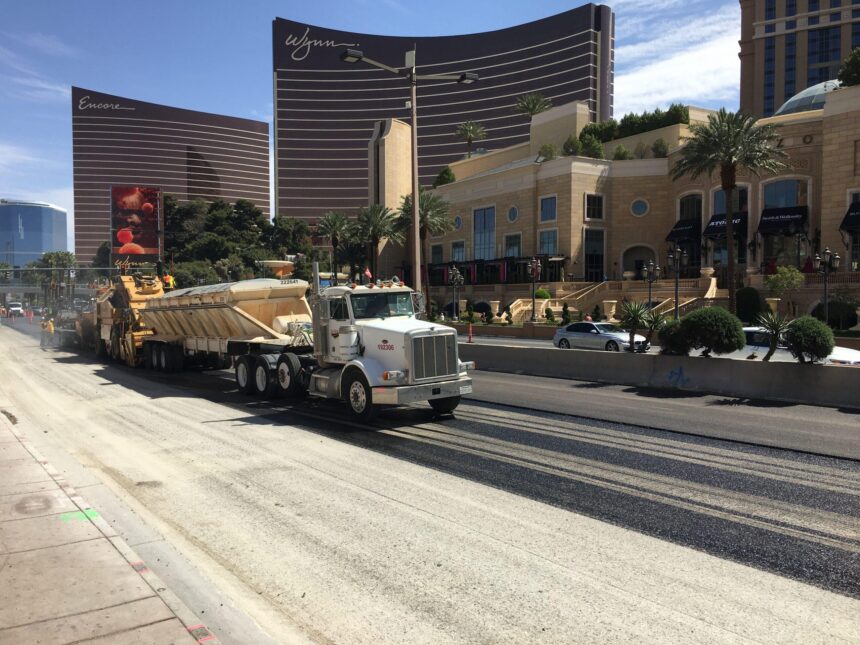Roadwork has officially begun on the iconic Las Vegas Strip as preparations accelerate for the highly anticipated 2025 Formula 1 Grand Prix. City officials and construction crews are working around the clock to upgrade key sections of the roadway, aiming to ensure a world-class racing experience for drivers and fans alike. The extensive infrastructure improvements underscore Las Vegas’ commitment to hosting a premier international sporting event that is expected to draw thousands of visitors and boost the local economy.
Roadwork Begins on Iconic Las Vegas Strip to Prepare for 2025 F1 Grand Prix
The bustling heart of Las Vegas is already feeling the impact of the extensive roadwork as the city gears up to host the 2025 Formula 1 Grand Prix. Crews have started modifying key sections of the Strip, enhancing race infrastructure and improving safety features to meet the rigorous standards of the global motorsport event. These upgrades include resurfacing the iconic roads, upgrading barriers, and installing state-of-the-art timing systems to support the high-speed race that will captivate millions worldwide.
Key elements of the ongoing construction include:
- Expanded pit and paddock areas for teams and officials
- Enhanced spectator viewing platforms and grandstands
- Upgraded lighting and sound systems for nighttime racing
- Improved traffic management plans to minimize disruption
| Project Component | Expected Completion | Impact |
|---|---|---|
| Road resurfacing | December 2024 | Improved grip and safety for drivers |
| Grandstand construction | February 2025 | Increased capacity for 30,000 fans |
| Safety barrier upgrades | January 2025 | Enhanced crash protection |
Key Infrastructure Upgrades Aimed at Enhancing Fan Experience and Safety
Significant upgrades are currently underway along the iconic Las Vegas Strip, specifically tailored to boost the overall experience for attendees of the 2025 F1 Grand Prix. These enhancements include the installation of cutting-edge crowd control systems, expanded shaded seating areas, and improved pedestrian pathways designed to facilitate smoother movement. Organizers have also prioritized emergency response readiness by incorporating advanced surveillance cameras and strategically placed first aid stations to ensure rapid assistance if needed.
Key improvements in the infrastructure:
- Widened walkways with non-slip surfaces for safer navigation
- LED wayfinding displays providing real-time event updates
- Enhanced lighting systems to improve nighttime visibility
- Additional security checkpoints equipped with the latest scanning technology
- Temporary barriers and fencing designed for efficient crowd segmentation
| Upgrade Feature | Benefit |
|---|---|
| Shaded Seating | Increased comfort during daytime races |
| Surveillance Systems | Enhanced safety through real-time monitoring |
| LED Wayfinding | Clear navigation and event details |
Traffic Management Strategies to Minimize Disruption During Construction Period
To ensure smooth traffic flow during the extensive roadwork on the Las Vegas Strip ahead of the 2025 F1 Grand Prix, an integrated approach has been adopted. Key tactics include the deployment of dynamic digital signage that provides real-time updates and alternative route suggestions to motorists. In addition, strategically placed traffic officers will manage peak hour congestion and facilitate pedestrian crossings to maintain safety and efficiency.Emphasis is also placed on promoting public transportation, with increased shuttle services and incentivized ride-sharing options to reduce the volume of private vehicles on the Strip.
Community and commuter benefits are further enhanced by:
- Temporary dedicated lanes for construction vehicles to prevent blockage of main thoroughfares
- Nighttime work schedules to minimize daytime disruptions
- Regular updates through local media and mobile apps for travelers’ convenience
| Strategy | Expected Impact |
|---|---|
| Dynamic Digital Signage | Real-time traffic flow optimization |
| Dedicated Construction Lanes | Reduced congestion on main roads |
| Nighttime Work Schedule | Lower daytime traffic delays |
| Enhanced Public Transit | Fewer private cars,less pollution |
Experts Recommend Early Travel Planning and Alternative Routes for Attendees
Attendees preparing for the 2025 F1 Grand Prix are urged to initiate their travel arrangements well in advance to navigate anticipated disruptions caused by ongoing roadwork on the Las Vegas Strip. Experts highlight that early planning not only helps in securing accommodations and transportation but also mitigates the stress linked to last-minute changes. Given the complexity of the construction zones, which will remain active throughout the event period, flexibility is key to ensuring smooth transit and timely arrival at race venues.
To ease congestion and enhance travel efficiency, officials suggest considering alternative routes and modes of transportation. Some recommended options include:
- Utilizing public transit: The Las Vegas Monorail and bus services are expected to operate with extended hours and increased frequency.
- Exploring side streets: Routes parallel to the Strip provide less congested pathways into downtown and surrounding areas.
- Carpooling and rideshares: These options can reduce traffic volume and parking demand.
- Bike-sharing programs: Expanded bike lanes encourage safer, eco-friendly travel within walking distance of the event.
Below is a rapid reference table highlighting suggested alternative routes and their estimated travel times compared to the main Strip corridor:
| Route | Estimated Travel Time | Traffic Level |
|---|---|---|
| Frank Sinatra Drive | 15 minutes | Moderate |
| Industrial Road | 12 minutes | Low |
| Paradise Road | 18 minutes | High |
| Eastern Avenue | 20 minutes | Moderate |
Future Outlook
As the Las Vegas Strip undergoes extensive roadwork in readiness for the 2025 Formula 1 Grand Prix, the city is positioning itself to host one of the most anticipated motorsport events in the world. These infrastructure upgrades not only promise to enhance the race experience for drivers and fans alike but also signal Las Vegas’s commitment to becoming a premier destination on the global racing calendar. With the race set to take center stage next year, all eyes will be on the Strip—as construction continues to transform the iconic boulevard into a world-class F1 circuit.







